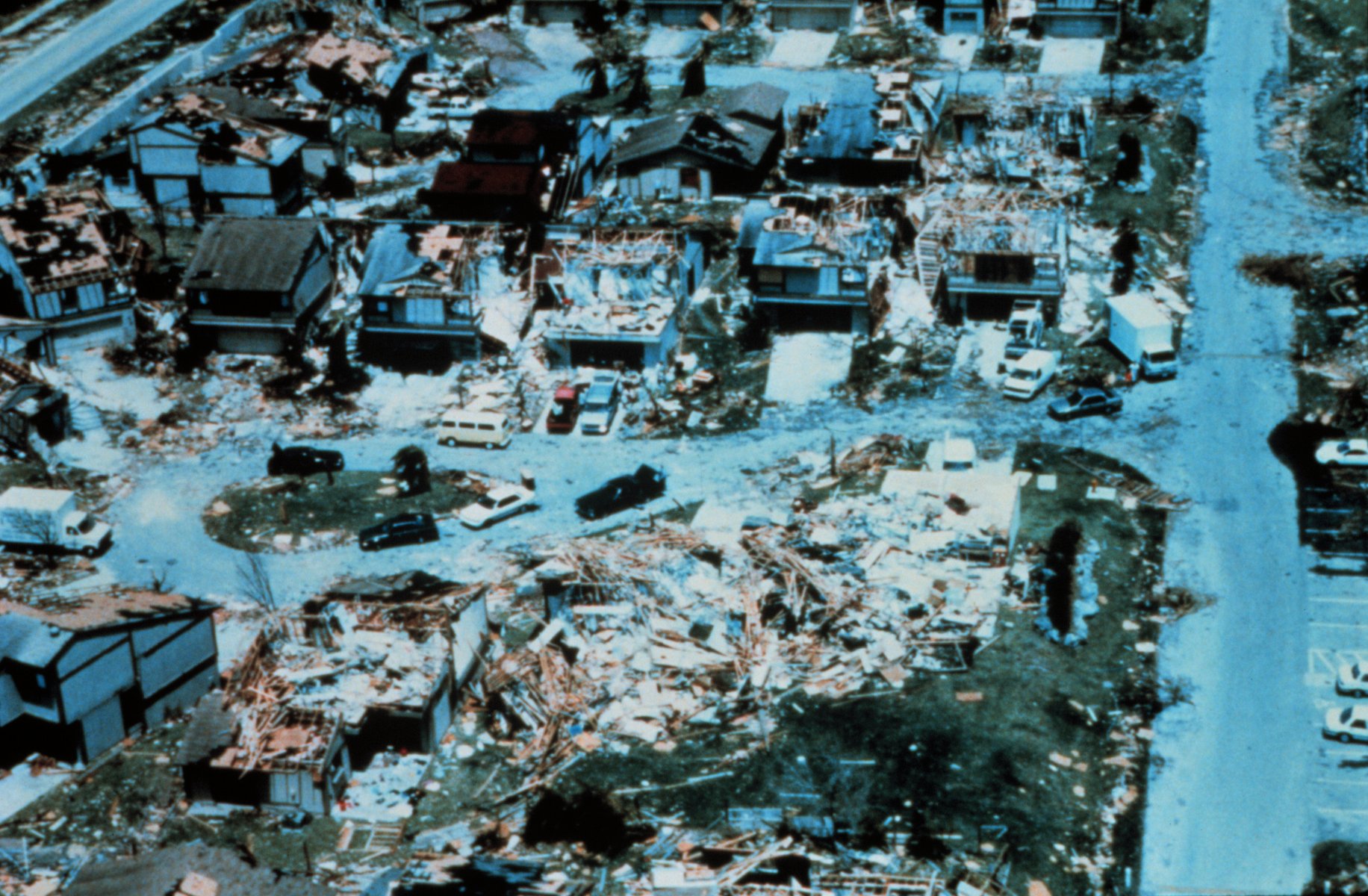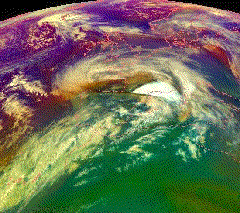|
Industry Loss Warranty
Industry loss warranties (ILWs), are a type of reinsurance contract used in the insurance industry through which one party will purchase protection based on the total loss arising from an event to the entire insurance industry above a certain trigger level rather than their own losses. For example, the buyer of a "$100million limit US Wind ILW attaching at $20bn" will pay a premium to a protection writer (generally a reinsurer but sometimes a hedge fund) and in return will receive $100million if total losses to the insurance industry from a single US hurricane exceed $20bn. The industry loss ($20bn in this case) is often referred to as the "trigger". The amount of protection offered by the contract ($100million in this case) is referred to as the "limit". ILWs could also be constructed based on an index not linked to insurance industry losses. For example, Professor Lawrence A. Cunningham of George Washington University suggests adapting similar mechanisms to the risks that ... [...More Info...] [...Related Items...] OR: [Wikipedia] [Google] [Baidu] |
Reinsurance
Reinsurance is insurance that an insurance company purchases from another insurance company to insulate itself (at least in part) from the risk of a major claims event. With reinsurance, the company passes on ("cedes") some part of its own insurance liabilities to the other insurance company. The company that purchases the reinsurance policy is called a "ceding company" or "cedent" or "cedant" under most arrangements. The company issuing the reinsurance policy is referred to as the "reinsurer". In the classic case, reinsurance allows insurance companies to remain solvent after major claims events, such as major disasters like hurricanes and wildfires. In addition to its basic role in risk management, reinsurance is sometimes used to reduce the ceding company's capital requirements, or for tax mitigation or other purposes. The reinsurer may be either a specialist reinsurance company, which only undertakes reinsurance business, or another insurance company. Insurance companies ... [...More Info...] [...Related Items...] OR: [Wikipedia] [Google] [Baidu] |
Catastrophe Bond
Catastrophe bonds (also known as cat bonds) are risk-linked securities that transfer a specified set of risks from a sponsor to investors. They were created and first used in the mid-1990s in the aftermath of Hurricane Andrew and the Northridge earthquake. Catastrophe bonds emerged from a need by insurance companies to alleviate some of the risks they would face if a major catastrophe occurred, which would incur damages that they could not cover by the invested premiums. An insurance company issues bonds through an investment bank, which are then sold to investors. These bonds are inherently risky, generally BB, and usually have maturities less than 3 years. If no catastrophe occurred, the insurance company would pay a coupon to the investors. But if a catastrophe did occur, then the principal would be forgiven and the insurance company would use this money to pay their claim-holders. Investors include hedge funds, catastrophe-oriented funds, and asset managers. They are ... [...More Info...] [...Related Items...] OR: [Wikipedia] [Google] [Baidu] |
Catastrophe Bond
Catastrophe bonds (also known as cat bonds) are risk-linked securities that transfer a specified set of risks from a sponsor to investors. They were created and first used in the mid-1990s in the aftermath of Hurricane Andrew and the Northridge earthquake. Catastrophe bonds emerged from a need by insurance companies to alleviate some of the risks they would face if a major catastrophe occurred, which would incur damages that they could not cover by the invested premiums. An insurance company issues bonds through an investment bank, which are then sold to investors. These bonds are inherently risky, generally BB, and usually have maturities less than 3 years. If no catastrophe occurred, the insurance company would pay a coupon to the investors. But if a catastrophe did occur, then the principal would be forgiven and the insurance company would use this money to pay their claim-holders. Investors include hedge funds, catastrophe-oriented funds, and asset managers. They are ... [...More Info...] [...Related Items...] OR: [Wikipedia] [Google] [Baidu] |
Reinsurance
Reinsurance is insurance that an insurance company purchases from another insurance company to insulate itself (at least in part) from the risk of a major claims event. With reinsurance, the company passes on ("cedes") some part of its own insurance liabilities to the other insurance company. The company that purchases the reinsurance policy is called a "ceding company" or "cedent" or "cedant" under most arrangements. The company issuing the reinsurance policy is referred to as the "reinsurer". In the classic case, reinsurance allows insurance companies to remain solvent after major claims events, such as major disasters like hurricanes and wildfires. In addition to its basic role in risk management, reinsurance is sometimes used to reduce the ceding company's capital requirements, or for tax mitigation or other purposes. The reinsurer may be either a specialist reinsurance company, which only undertakes reinsurance business, or another insurance company. Insurance companies ... [...More Info...] [...Related Items...] OR: [Wikipedia] [Google] [Baidu] |
Alternative Risk Transfer
Alternative risk transfer (often referred to as ART) is the use of techniques other than traditional insurance and reinsurance to provide risk-bearing entities with coverage or protection. The field of alternative risk transfer grew out of a series of insurance capacity crises in the 1970s through 1990s that drove purchasers of traditional coverage to seek more robust ways to buy protection. Most of these techniques permit investors in the capital markets to take a more direct role in providing insurance and reinsurance protection, and as such the broad field of alternative risk transfer is said to be bringing about a convergence of insurance and financial markets. Areas of activity A major sector of alternative risk transfer activity is risk securitization including catastrophe bonds and reinsurance sidecars. Standardization and trading of risk in non-indemnity form is another area of alternative risk transfer and includes industry loss warranties. In addition, a number of ap ... [...More Info...] [...Related Items...] OR: [Wikipedia] [Google] [Baidu] |
Hurricane
A tropical cyclone is a rapidly rotating storm system characterized by a low-pressure center, a closed low-level atmospheric circulation, strong winds, and a spiral arrangement of thunderstorms that produce heavy rain and squalls. Depending on its location and strength, a tropical cyclone is referred to by different names, including hurricane (), typhoon (), tropical storm, cyclonic storm, tropical depression, or simply cyclone. A hurricane is a strong tropical cyclone that occurs in the Atlantic Ocean or northeastern Pacific Ocean, and a typhoon occurs in the northwestern Pacific Ocean. In the Indian Ocean, South Pacific, or (rarely) South Atlantic, comparable storms are referred to simply as "tropical cyclones", and such storms in the Indian Ocean can also be called "severe cyclonic storms". "Tropical" refers to the geographical origin of these systems, which form almost exclusively over tropical seas. "Cyclone" refers to their winds moving in a circle, whirling round ... [...More Info...] [...Related Items...] OR: [Wikipedia] [Google] [Baidu] |
Goldman Sachs
Goldman Sachs () is an American multinational investment bank and financial services company. Founded in 1869, Goldman Sachs is headquartered at 200 West Street in Lower Manhattan, with regional headquarters in London, Warsaw, Bangalore, Hong Kong, Tokyo, Dallas and Salt Lake City, and additional offices in other international financial centers. Goldman Sachs is the second largest investment bank in the world by revenue and is ranked 57th on the Fortune 500 list of the largest United States corporations by total revenue. It is considered a systemically important financial institution by the Financial Stability Board. The company has been criticized for a lack of ethical standards, working with dictatorial regimes, close relationships with the U.S. federal government via a "revolving door" of former employees, and driving up prices of commodities through futures speculation. While the company has appeared on the 100 Best Companies to Work For list compiled by ''Fortune'' ... [...More Info...] [...Related Items...] OR: [Wikipedia] [Google] [Baidu] |
Willis Group Holdings
Willis Group Holdings plc was a multinational risk advisor, insurance brokerage and reinsurance brokerage company with its headquarters in the Willis Building in London until its merger of equals with financial services company Towers Watson in 2016. It was the world's third-largest insurance broker when measured by revenues. Willis has around 400 offices in 120 countries and approximately 18,000 employees. Willis was previously listed on the New York Stock Exchange before its early-2016 'merger of equals' with Towers Watson. After the deal closed, the combined company began trading on the Nasdaq exchange under the symbol, WLTW ( Nasdaq: WLTW). History The company was founded by Henry Willis in London in 1828, and initially operated as Henry Willis & Co. In 1898 it merged with Faber Brothers (founded in 1886) to form ''Willis Faber'', and then in 1928 it merged with Dumas & Wylie (founded in 1843) to create ''Willis, Faber & Dumas''. It was first listed on the London Stoc ... [...More Info...] [...Related Items...] OR: [Wikipedia] [Google] [Baidu] |
European Windstorm
European windstorms are powerful extratropical cyclones which form as cyclonic windstorms associated with areas of low atmospheric pressure. They can occur throughout the year, but are most frequent between October and March, with peak intensity in the winter months. Deep areas of low pressure are common over the North Atlantic, and occasionally start as nor'easters off the New England coast. They frequently track across the North Atlantic Ocean towards the north of Scotland and into the Norwegian Sea, which generally minimizes the impact to inland areas; however, if the track is further south, it may cause adverse weather conditions across Central Europe, Northern Europe and especially Western Europe. The countries most commonly affected include the United Kingdom, Ireland, the Netherlands, Norway, Germany, the Faroe Islands and Iceland. The strong wind phenomena intrinsic to European windstorms, that give rise to "damage footprints" at the surface, can be placed into three cat ... [...More Info...] [...Related Items...] OR: [Wikipedia] [Google] [Baidu] |
Insurance
Insurance is a means of protection from financial loss in which, in exchange for a fee, a party agrees to compensate another party in the event of a certain loss, damage, or injury. It is a form of risk management, primarily used to hedge against the risk of a contingent or uncertain loss. An entity which provides insurance is known as an insurer, insurance company, insurance carrier, or underwriter. A person or entity who buys insurance is known as a policyholder, while a person or entity covered under the policy is called an insured. The insurance transaction involves the policyholder assuming a guaranteed, known, and relatively small loss in the form of a payment to the insurer (a premium) in exchange for the insurer's promise to compensate the insured in the event of a covered loss. The loss may or may not be financial, but it must be reducible to financial terms. Furthermore, it usually involves something in which the insured has an insurable interest established by ... [...More Info...] [...Related Items...] OR: [Wikipedia] [Google] [Baidu] |
Munich Re
Munich Re Group or Munich Reinsurance Company (german: Münchener Rück; Münchener Rückversicherungs-Gesellschaft) is a German multinational insurance company based in Munich, Germany. It is one of the world's leading reinsurers. ERGO, a Munich Re subsidiary, is the Group's primary insurance arm. Munich Re's shares are listed on all German stock exchanges and on the Xetra electronic trading system. Munich Re is included in the DAX index at the Frankfurt Stock Exchange, the Euro Stoxx 50, and other indices. History In 1880 Carl von Thieme, a native of Erfurt who was the representative in Bavaria of his father's ''Thuringia'' insurance company, founded in Munich ''Münchener Rückversicherungs-Gesellschaft'' together with Wilhelm von Finck (co-owner of the Merck Finck & Co. bank) and Theodor von Cramer-Klett. This was followed by the founding of Allianz Versicherungs-Gesellschaft in 1890 in Berlin. Carl von Thieme was head of Munich Re until 1921, and Wilhelm von Finck ... [...More Info...] [...Related Items...] OR: [Wikipedia] [Google] [Baidu] |
Swiss Re
Swiss Reinsurance Company Ltd, Swiss Re. Retrieved on 18 January 2011. "Swiss Reinsurance Company Ltd ("Swiss Re") .. and "Swiss Reinsurance Company Ltd, Mythenquai 50/60, 8022 Zurich, Switzerland ("Swiss Re" Disclosure notification in accordance with Article 20 of the Swiss Stock Exchange Act " Swiss Re. 2 August 2007. Retrieved on 18 January 2011. "Die Schweizerische Rückversicherungs-Gesellschaft (Swiss Re) teilt mit, .. commonly known as Swiss Re, is a |

.jpg)


